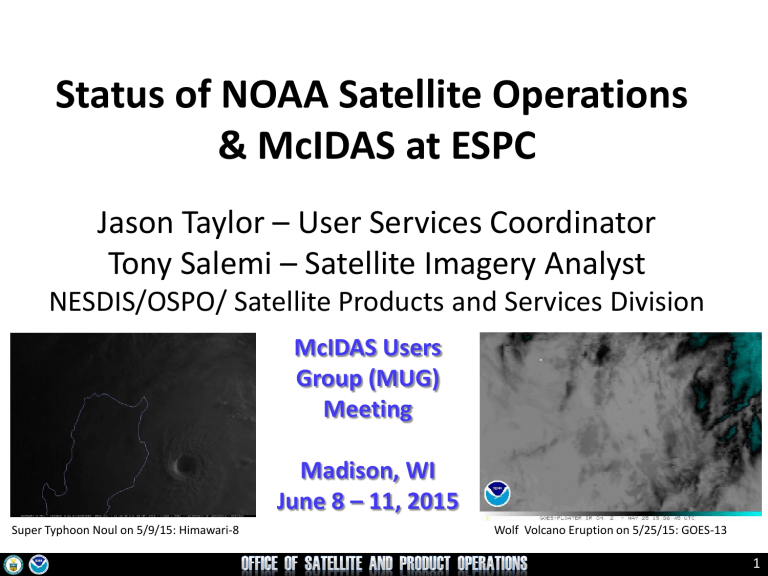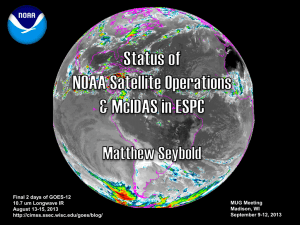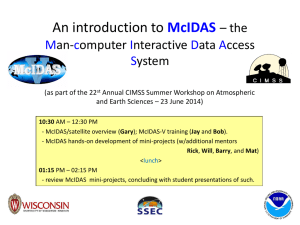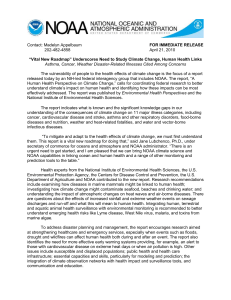Status of NOAA Satellite Operations & McIDAS at ESPC

Status of NOAA Satellite Operations
& McIDAS at ESPC
Jason Taylor – User Services Coordinator
Tony Salemi – Satellite Imagery Analyst
NESDIS/OSPO/ Satellite Products and Services Division
Super Typhoon Noul on 5/9/15: Himawari-8
McIDAS Users
Group (MUG)
Meeting
Madison, WI
June 8 – 11, 2015
Wolf Volcano Eruption on 5/25/15: GOES-13
1
ESPC Coordination for MUG Talk
NESDIS / OSPO / SPSD @ NCWCP
• Matt Seybold, GOES-R Data Ops Manager
• Natalia Donoho, User Services Coordinator
• Clay Davenport, Senior Product Programmer
• Robert Glassberg, Senior Product Programmer
• Tom Renkevens, SPSD Division Chief
• Shuang Qiu, Suomi NPP PAL
• John Paquette, Physical Scientist
NESDIS / OSPO / SPSD / SAB @ NCWCP
• Mark Ruminski, Fire Team Lead & All Desks
• Davida Street, Branch Chief
NESDIS / OSPO / MOD @ NSOF
• Bonnie Morgan, GOES Product Area Lead
• Donna McNamara, Data Access Manager
National Center for Weather & Climate Prediction
(NCWCP)
NOAA Satellite Operations Facility (NSOF)
2
Presentation Overview
- Overview of the Office of Satellite and Product Operations (OSPO)
- Satellite Status and Updates
- GOES, POES, Suomi NPP
- Data Access and Distribution
- McIDAS at ESPC
- McIDAS at Satellite Analysis Branch’s Tony Salemi
- GOES-R McIDAS Data for Users
- Himawari-8 Project Status and Update
- Q&A
3
NESDIS Office of Satellite and Product Operations (OSPO)
• Operates the Nation’s 15 environmental satellites:
– 3 Geostationary (GOES) by NOAA
– 4 Polar-Orbiting (POES) by NOAA
– 6 Defense Meteorological Satellite program (DMSP) operated by
NOAA
– 1 OSTM Jason-2 (Ocean Surface Topography Mission) - Joint
NOAA, NASA, CNES, EUMETSAT effort
– 1 Suomi National Polar-orbiting Partnership (NPP) by NOAA &
NASA
4
NESDIS Office of Satellite and Product Operations (OSPO)
• OSPO has locations at four major facilities housing around 700 people.
• NOAA Satellite Operations Facility (NSOF) in Suitland, Maryland
– Mission Operations Division (MOD)
• NOAA Center for Weather & Climate
Prediction (NCWCP) in College Park,
Maryland.
– Satellite Product and Services Division (SPSD)
• Command and Data Acquisition Stations in
Alaska and Virginia.
NSOF
Fairbanks CDAS
NCWCP
Wallops CDAS
5
OSPO’s Key Roles
• Ground System Command & Control,
Ingest, Generation, and Distribution
• Pre-Launch and Post-Launch Testing
• Operational Testing, Validation, and
Verification
• User Readiness for Broadcast Services and Product Delivery
• Long-Term Continuity of Products and
Services
6
Satellite Operations, Processing and Distribution
SNPP/JPSS-1 (PM) POES NOAA-19
GOES-West GOES-East
Non-NOAA
(Jason2, DMSP, Meteosat, MTSAT,
Metop, EOS, COSMIC, others)
Center for Satellite Applications and Research (STAR)
Product Development
Algorithm Development
Science Maintenance
Office of Satellite and Product Operations (OSPO)
METOP-B/C (AM)
TDRSS
Fairbanks Wallops
Command and Control
Satellite Operations Control Center
Suitland
Svalbard McMurdo / Troll
Processing and Distribution
Environmental Satellite Processing Center
Office of Satellite Ground Services (OSGS)
Ground Systems Development and Sustainment,
IT Enterprise Architecture
Data and
Products
Archive and Access
NESDIS Data Centers
Customers
7
Products (Derived & Interpretive)
Atmospheric Chemistry
Atmospheric Temperature
Fire and Smoke
Hurricane Intensity and Position
Imagery (e.g. Visible, IR, WV)
Land Cover – Ice, Snow, Vegetation
Ocean Color
Satellite Derived Winds (WS,WD,H)
Sea Surface Height & Temperature
Sounder Profiles and Imagery
Space Weather
Volcanic Ash and many more…
8
Direct Service Operations
Emergency Managers Weather Information Network (EMWIN):
• NOAA satellites relay critical information to users across the country.
http://www.weather.gov/emwin/index.htm
Low Resolution Image Transmission (LRIT):
• NOAA satellites are used to relay satellite and weather products to users in remote
locations, that do not have landlines or internet connections . http://www.noaasis.noaa.gov/LRIT/
Data Collection:
• NOAA satellites are used to collect and relay scientific data from around the globe. http://www.noaasis.noaa.gov/DCS/ http://www.noaasis.noaa.gov/ARGOS/
Search and Rescue Satellite Aid Tracking (SARSAT):
• NOAA satellites are used to relay distress alerts from aviators, mariners and
land-based users ( 75 rescued through May 22, 2015 ). http://www.sarsat.noaa.gov/
Geonetcast Americas:
• Data from NOAA for diverse societal benefits - agriculture, energy, health, climate,
weather, disaster mitigation, biodiversity, water resources, and ecosystems.
http://www.geonetcastamericas.noaa.gov/index.html
9
GOES Status
Service
GOES-15
(West)
GOES-14
(Standby)
GOES-13
(East)
LRIT Operational Standby Operational
EMWIN Operational Standby Operational
SARSAT Operational Standby Operational
DCS Operational Standby Operational
GVAR Operational Standby Operational
See summary of GVAR Instrument Factory Coefficients and Detector Offsets by Block: http://www.osd.noaa.gov/GVAR_Downloads/gvar_downloads.html
10
GOES Status (May 4, 2015)
Key
Operational
G
Spacecraft
Issues, but
No User
Impacts
S/C http://www.ospo.noaa.gov/Operations/GOES/status.html
Operational with
Limitations
Y
Non-
Operational
R http://www.ospo.noaa.gov/Operations/GOES/status.html
11
GOES-13 (East)
Launch: May 2006 | Operational: April 2010
Issue #1 :
Sounder filter wheel anomaly.
Sounder frame sync losses.
Impact:
Sounder pixel dropouts
(minimal).
Issue #2 :
CRS capacitor short.
Impact:
XRS X-ray measurements can potentially invert unexpectedly.
Issue #3 :
SXI detector damage due to flare.
Impact:
Nine rows currently affected out of 512 total.
12
GOES-14 (Standby)
Launch: June 2009 | Operational: N/A
No Spacecraft or
Instrument Issues
13
GOES-15 (West)
Launch: March 2010 | Operational: Dec 2011
Issue #1 :
Star Tracker1 (ST1) and Star
Tracker2 (ST2) failure.
Operations with ST3 only.
Impact:
Degraded INR performance in both E/W and N/S directions.
Issue #2:
Sounder temperature control blanket is raised. To maintain patch temperature control, a yaw flip at Equinox to keep
Sun angle below cooler plane.
Impact:
1 hour data outage and degraded products during each yaw flip maneuver and
28 hours of INR (Image
Navigation & Registration) recovery period.
14
GOES-East Optimized Schedule
Increased the coverage from the GOES-13 imager (May 2014). The size and/or start time of certain sectors was changed. More information is available at http://cimss.ssec.wisc.edu/goes/blog/archives/15068
CONUS sector
(before)
More Data
Optimized
CONUS sector
(after)
Comparison of the size of the Continental U.S. sector (before, left) and the extended coverage (after, right).
15
South America RSO Frames Created
GOES-13 (East) Rapid Scan Operations (RSO) South America
Frames were created to drastically improve coverage
South America Central (SAC) South America South (SAS )
16
New GOES-West RSO Sectors
• Requested by the NWS Alaska and Pacific Regions - NESDIS developed three additional operational GOES- West RSO sectors for GVAR and AWIPS broadcast; Alaska SITKA and
Alaska TPARC, and Hawaii
– RSO sectors are available for NOAA user call-up, 24x7 operations
– Still working out requirements/code changes for American Samoa. http://cimss.ssec.wisc.edu/goes/blog/archives/16856 http://cimss.ssec.wisc.edu/goes/blog/archives/17027
Hawaii Alaska Frames
TPARC SITKA American Samoa
17
GOES-13 Sounder Dropped Data
A correction that re-claims previously missing Sounder data was developed by OSPO, working with Exelis and others. These re-claimed data were provided, and then qualitatively and quantitatively analyzed at CIMSS. This correction is now operational (March 2014).
GOES-13 Sounder water vapor band (11) showing the missing data with the current image (left), along with the corrected and re-processed image (right) with a test version of the SPS (Sensor
Processing System). While one band is shown, all GOES-13 Sounder bands are affected.
18
GOES-14 Super Rapid Scan Operations (SRSOR)
• GOES-14 provided very unique data and offered a glimpse into the possibilities that will be provided by the ABI on GOES-R in one minute mesoscale imagery
• Past GOES-14 SRSOR schedule
– Jun 12–14, Aug 19–28, 2013
– May 8–22, Aug 14–28, 2014 http://cimss.ssec.wisc.edu/goes/srsor2015/GOES-
14_SRSOR.html
http://cimss.ssec.wisc.edu/goes/srsor/GOES-
14_SRSOR.html
http://cimss.ssec.wisc.edu/goes/srsor2013/GOES-
14_SRSOR.html
http ://cimss.ssec.wisc.edu/goes/srsor2014/GOES-
14_SRSOR.html
• SRSOR provided May 18-Jun 12,
2015, planned for Aug 10-22, 2015 http://cimss.ssec.wisc.edu/goes/srsor2015/GOES-
14_SRSOR.html
GOES-14 visible image showing rapid convective development
19
GOES-13 Imager Co-Registration
Currently testing an updated GOES Imager co-registration correction.
More information is available at: http://fusedfog.ssec.wisc.edu/?p=910#Update17November and http://cimss.ssec.wisc.edu/goes/blog/archives/17705
Improved product with latest (Feb 2015) imager co-registration correction
20
GOES Flyout Schedule
-
http://www.nesdis.noaa.gov/flyout_schedules.html http://www.goes-r.gov
21
POES Status (April 24, 2015)
http://www.ospo.noaa.gov/Operations/POES/status.html
Operational
Spacecraft Issue but no User Impact
Operational with Limitation
Non-Operational
Not Applicable
G
S/C
Y
R
N/A
22
Suomi NPP – Milestones
Launched in October, 2011
Date
1 / 2014
Activity
ATMS/CrIS SDR to JMA, CMC, India-NCMWRF
2/ 2014 MiRS to NCO
6 / 2014 VIIRS Polar Winds to NCO, EUMETSAT, JMA, CMC
NDE PE2 System Readiness Review
7 / 2014 NDE PE2 handover
8 / 2014
2 / 2015
OMPS NP/TC Ozone to JMA
Green Vegetation Fraction to NCO & CLASS
5 / 2015 ACSPO SST L3 product to EUMETSAT
6 / 2015 Microwave Tropical Cyclone Products to JTWC & NCO
23
LEO Flyout Schedule - April 2015
http://www.nesdis.noaa.gov/flyout_schedules.html http://www.jpss.noaa.gov
24
Data Access Services
• Current Access Services (in addition to Direct Broadcast)
– Data Distribution Service (DDS) – (s)FTP push/pull from secure accounts *
– NWS Telecommunications Gateway
– GINI (GOES Ingest and NOAAPORT Interface) / NOAAPORT for
Advanced Weather Interactive Processing System (AWIPS) display
– GEODIST – GOES, POES, and Derived Products; McIDAS *
– Shared Processing DAPE Gateway – for military partners *
– MODIS server – subset of products made by NASA *
– Websites - http://www.ospo.noaa.gov/
* Require Data Access Request
• Archival
– NODC, NGDC, and NCDC archive data products using CLASS
25
McIDAS Data Delivery Summary
GEODIST –
Geostationary satellite data is ingested on a SSEC Data Ingestor (SDI), converted to McIDAS format and placed on a server.
In addition, some foreign geostationary data, polar data, model data and derived products are converted into McIDAS.
This data is served via McIDAS ADDE:
– Data NSOF Server ADDE Name
– Derived Products GEODIST1e DPD
– GOES-E
– GOES-W
GEODIST2e
GEODIST3e
GER
GWR
– Polar
– Model data
GEODIST4e
GEODIST5
– Global Mosaic 5 Sat. Comp. GEODIST6
PLR
MOD
MOS
– MSG/MET
–
–
MTSAT
Select requested data
GEODIST6e
GEODIST7e
MSG / MET
MTS
SATEPSANONE PUB (not operational)
– Surface/Ship Buoy/RAOBs FOS2 FOS (Family of Services)
26
Data Access & Distribution Policy
• Full policy and forms at http://www.ospo.noaa.gov/Organization/About/access.html
• Security requirement to know and document all users accessing operational data servers and what products they are receiving
– Users request data using a Data Access Request (DAR) form.
• Ever increasing data volume requires prioritization of users to effectively manage distribution resources and ensure effective system performance
• Higher priority access will be given to organizations with:
– Mission and statutory authority
– Signed NESDIS cooperative agreements or legislative authorities
– A demonstrated timeliness requirement for near-real time data to support operational user applications
• If available and sufficient, users will be directed to sources of data external to NESDIS (e.g. CIMSS). Also recommend alternatives for denied users
Cloud
Top
Pressure
Lifted
Index
27
Near Future Data Access & Distribution
• New enterprise system Product Distribution and Access (PDA) is coming in summer 2016
• Will be used for legacy GOES/POES, NPP/JPSS, and GOES-R data access
• Operational Readiness Review (ORR) for December 2015
• McIDAS ADDE access will remain on GEODIST
Backup for PDA is to serve
NPP/JPSS only at
CBU (Fairmont,
WV). GOES-R &
Legacy are not yet planned.
28
ESPC Notifications, Status, and Contacts
24/7 Help Desk
ESPC Messages
ESPCOperations@noaa.gov
http://www.ssd.noaa.gov/PS/SATS/messages.html
WMO GTS Bulletins Urgent: http://www.weather.gov/view/validProds.php?prod=ADM&node=KNES
Routine: http://www.weather.gov/view/validProds.php?prod=ADA&node=KNES
User Services SPSD.UserServices@noaa.gov
Data Access
Webmaster
NESDIS.Data.Access@noaa.gov
SSDWebmaster@noaa.gov
Facebook www.facebook.com/NOAANESDIS
Twitter www.twitter.com/noaasatellites
Satellite Ops Status http://www.oso.noaa.gov/daily-news/index.asp
Press releases
Web http://www.nesdis.noaa.gov/news_archives/ www.ospo.noaa.gov
29
McIDAS & ESPC Applications
• Over 50 applications in ESPC use McIDAS, McIDAS libraries, input & serve McIDAS AREA Files, MD point files, GRID (McIDAS GRID
Format), and Text via ADDE
• ADT, ABBA, CSBT, HMS, others…
30
Ad hoc McIDAS Usage at ESPC
• Heavy usage of the local GINI server in McIDAS format for validation checks (image previews) for conversion of GOES-13 and GOES-15 data to NWS AWIPS
• Great reliance on GINIs during GOES-13 anomalies to confirm the output images quickly and efficiently (Generated mock
AWIPS files to confirm changes to use GOES-14).
• GINIs, remappers, and Level 2 products that utilize McIDAS were all used for
– The GOES-13 rapid schedule (to compensate for GOES-12 decom)
– The GOES-13 optimized routine schedule
31
McIDAS Systems at ESPC
• Over 20 SDIs at NSOF and Wallops OBF
• Several are dedicated...
• GOES-East, -West, -14, Remappers
• MTSAT Remapper
• GOES Ingest and NOAAPORT
Interface (GINI)
• Over 20 Workstations in SAB
• -X for realtime analysis, product generation, and QA/QC
• RHEL 6 Linux on Intel x86_64
• Many “home grown” programs in
Fortran, .PGM, BATCH
• Advantage - The ADDE protocol allows
for many users accessing single
systems with one port (112)
Global Hydro-Estimator 1 Day Total
• ESPC Product Generation/Distribution
• IBM P6 Series with Linux Partitions
• Many other Linux systems (gp*)
• GINI running on Linux
32
McIDAS at ESPC
•
ESPC has a standing, annual contract with SSEC for McIDAS Support and ongoing development
•
ESPC representatives on the McIDAS Advisory
Committee (MAC)
– Bonnie Morgan (GOES Product Area Lead)
– Jason Taylor (User Services Coordinator)
– Tony Salemi (Satellite Imagery Analyst)
33
SAB Use of McIDAS
•
•
•
•
•
•
SAB is 24x7 operation of 5 disaster mitigation desks
(Heavy Precipitation, Volcanic Ash, Fire/Smoke/Dust,
Marine Pollution, Tropical Cyclones) All desk use Mc-X in some capacity, except Marine which is ArcGIS
McIDAS-X Usage: ~10 operational Linux systems with
24 GB RAM each and multiple monitor visualization setup
A persistent daemon (image loop refresh) “SPIDER” uses ADDE protocol to display ~100 imagery loops
Use Fnc keys to switch loops and pan entire globe through SPIDER loaded frames (e.g. NW Pacific IR,
Shift+F1 - NW Pacific Vis, F2 - Central US IR) and still use command line (grudgingly)
Lots of batch commands and everything is scripted by business work flow
Uses McIDAS AREA files for web site as do NWS offices across country, namely NHC, AWC, NWS
Western Region
34
McIDAS Advantages in SAB
• Institutional knowledge - SAB Analysts have great familiarity with McIDAS
• Ability to have near-global coverage at multiple domain scales and resolution (~980 frames) of quickly and routinely loaded
(SPIDER) imagery at the tap of a button (TU Hotkeys) to perform interrogation, manipulation and value-added analysis when every second counts for time sensitive and rapidly evolving natural and man-made hazards; such as volcanic eruptions, flash flooding, fires, etc.
– This cannot be done presently with NAWIPS or HMS. In fact, depending on the area of concern up to 20 minutes is lost waiting for imagery to show up on these other systems vs McIDAS
– HOWEVER, since the NWS is the primary user of many SAB products (e.g. volcanic ash and heavy precipitation), there are benefits for SAB to conduct PG on NAWIPS like, quick overlays and seamless in-tool distribution. Fire uses HMS for analysis.
35
McIDAS Challenges in SAB
• Maintaining efficient access to servers for operations (SPIDER is inhouse stop-gap measure).
• Additional customer requirements for advanced data formats (GIS,
KMZ)… writing own local code for NPP VIIRS, Windsat, others to convert them to AREA files as there are no local servers
• Learning Curve with commands
• Color Tables – only 8 bit – challenge with upcoming GOES-R
North Hemi Composite - IR
36
SPider
S
atellite
P
roduct
I
nformation
D
istribution
E
nvi
R
onment
Expands on concepts of Core Mcidas commands concepts
ADDE, DATALOC, DSSERVE, PT/GRD/IMGLIST, PT/GRD/IMGDISP,
PT/GRD/IMGCOPY, SKL, etc.
Consists of two programs: Spider Server (SPS) and Spider Client (SPC)
Benefits:
-- Automatic loading without duplication of images
-- Reduces task loading of server/workstations
• Numerous pings to server but fewer downloads
-- Run from command line environment (typically SKL) on all platforms
• Leads to distribution system effectiveness
-- Timely, based on user needed requirements (set to any refresh rate)
37
Two Types of SPider
•
Spider Client (SPC)
• User
– Resides on Workstation
– Keeps Request File of user defined loop(s) specifications and polls it against the Server Availability File
– Pulls “area” files from server and loads it into predetermined frame
•
Spider Server (SPS)
• Host
– Resides on Server
– Integrated into “Area generator” that creates products on the server
– Keeps and up to date Availability
List of these products
SPC
SPS
38
Washington Volcanic Ash Advisory Center (VAAC)
39
Tropical Cyclone Position and Intensity Estimates
40
Fire, Smoke and Dust Identification
41
Fire, Smoke and Dust Identification
42
Fire, Smoke and Dust Identification
43
Satellite Interpreted Precipitation Estimates
44
Marine Pollution Surveillance
45
Future SAB Use of McIDAS
• NAWIPS, McIDAS-X, & ENVI/IDL currently used
• Transition to AWIPS2 and an enhanced Hazard Mapping
System (HMS) within ENVI/IDL in one year.
• Imagery file formats needed (HDF, geoTIFF, netCDF)
• McIDAS-V to be used for intense image interrogation, manipulation and value-added analysis.
46
GOES-R McIDAS Data for Users
• Recent concerns:
– Current GEODIST McIDAS ADDE servers not sized to handle GOES-R (nor
Himiwari-8) data.
– No funds currently programmed for GOES-R (nor Himawari-8) distribution.
– Limited set of NCEP remote centers, which have not yet made plans to accommodate their GOES-13/14/15 data operations.
• User impacts:
– NCEP Remote National Centers (AWC, SPC, NHC) rely on ADDE protocol for post-processing and web production of their products.
– AWIPS NCP will also utilize GRB (no McIDAS data are included) as a means of receiving GOES-R data, so only some of their essential specialized products
(sectorized, filtered, stretched, blended, channel-selected, generated to web) are impacted.
– The NCEP centers located in College Park, MD (NCO, CPC, WPC, OPC) as well as
SWPC in Boulder, CO do not have this ADDE need.
47
GOES-R McIDAS Data for Users
• Recent Status:
– NWS is looking into the employment of ADDE servers on-site at the three remote centers.
– The GOES-R SSEC Data Ingestor (SDI) solution was previously advertised for delivery in April, 2015.
– Status report indicates development work progressing.
Looking forward to delivery.
– Concern regarding the status of GOES-R data read and translate (NetCDF to McIDAS Area) capability in the client-side McIDAS software.
48
Himawari-8 Project Status & Plans
Interim Demonstration Capability (IDC)
• Beginning on July 7, 2015, JMA will declare Himawari-8 operational.
– STAR currently is committed to hosting the IDC for 12 months (data processing & product generation) from July 2015 to July 2016.
– Support by STAR is provided during normal working hours during the IDC period.
– NESDIS/STAR will make available radiances and AMVs in BUFR for user testing
• JMA will terminate MTSAT-2 service in November 2015 (users notified).
• H-8 is planned to transition to full operational capability at the NSOF in July 2016 and/or after PDA is declared operational.
– The operational Data Ingest and Distribution functional areas will be provided by the
Product Distribution and Access (PDA) subsystem, currently in development and test.
– The requirement for PDA delays implementation at the NSOF, resulting in a need for an
Interim Demonstration Capability until 2016.
Himawari 8/9
*
*H-9 is the planned replacement to H-8 at its end of life (2022)
Himawari 8/9 Data
Standard Data Format
JMA
Data Ingest
Data Processing and Product
Generation
NOAA NESDIS
Data and Product
Distribution
Himawari 8/9
Data and Product
Users
NWS
49
Himawari-8 Project Status & Plans
• Recent Events & Accomplishments:
– Began testing receipt of data from Japan Meteorological Agency
HimawariCloud on 16 March 2015; operational testing began in April
2015.
– NESDIS/STAR receiving H-8 HSD level 1b file via JMA’s HimawariCloud during IDC.
– NWS NCEP is pulling test data to generate segmented files for AWIPS2 in NetCDF4 format.
– NESDIS is analyzing data transmissions including reliability and data latency
• Reduced to 5 minutes from initial 8 minutes observed.
First test images from Himawari-8
(Image credit: 18 December 2014,
Japan Meteorological Agency)
Himawari-8 Spacecraft (Image Credit:
Mitsubishi Electric Corporation)
50
Current Himawari-8 Images
•
Image Loops from Colorado State University
– Himawari-8 Band 13 (10.4 µm) - Sector 6
Click image for live data image loop (live internet required)
51
Himawari Project Plans and Status
•
Recent Customer Inquiries:
– Ensure SSEC/CIMSS plans to provide H-8 McIDAS
ADDE server for users.
– Request for SSEC to enable user access (e.g.
ADDE) to H-8 McIDAS area files from their site.
52
Thank You SSEC!
We appreciate you!
Questions?
53



